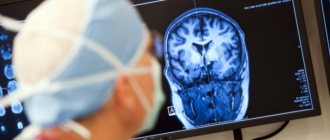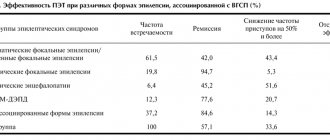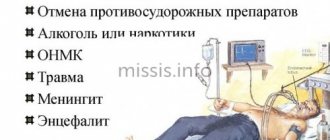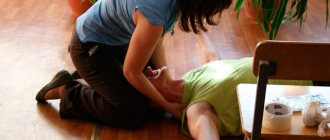Symptoms of Lennox-Gastaut syndrome
With Lennox-Gastaut syndrome, a child experiences frequent epileptic seizures throughout the day, and the duration of the seizures can range from short to long.
The most common are paroxysms of falls, tonic seizures (mainly at night), atonic, myoclonic seizures and absence seizures. Approximately half of the patients suffer from status epilepticus, accompanied by dizziness, apathy and lack of response to external stimuli. Epileptic seizures lead to frequent falls and trauma to the patient.
Approximately 70% of all cases of Lennox-Gastaut Syndrome are associated with pre-existing brain disease, disruption of brain development (in utero, during childbirth, or in infancy) and injury to the frontal lobe of the brain. The disease is often caused by encephalopathy, tuberculous sclerosis, metabolic diseases affecting the central nervous system, inflammatory diseases of the brain, and severe infections of the central nervous system.
In other cases, we are talking about idiopathic epilepsy, that is, a disease that developed without any visible prerequisites.
Lifestyle of sick men and women
Thanks to the capabilities of modern medicine, epileptics can lead a normal life. However, he must follow some rules to prevent the development of a seizure:
- Avoid places with large crowds of people, climate changes, time zones.
- Avoid stress.
- Don't drink alcohol.
Do not stay in the sun for a long time, in a bathhouse, or a sauna, so as not to provoke overheating. Maintain a daily routine. Good sleep, alternating work and rest, and proper nutrition are important for the patient. Patients can play sports, but participation in competitions is prohibited.
As for pregnancy and childbirth, there is no clear opinion on this matter. According to statistics, 90% of women suffering from epilepsy normally carry and give birth to healthy children.
Absolute contraindications to pregnancy are:
- Frequent generalized attacks that are not amenable to drug treatment.
- Visible personality disorders of a woman.
- Epistatus.
In other cases, pregnancy is not contraindicated. Six months before conception, a woman should undergo a full examination and discuss pregnancy management tactics and possible risks with her doctor.
The issue of military service with this disease is relevant. Young people with epilepsy can be drafted into the army as Category B4 (fit with minor restrictions) if they are not taking anti-seizure drugs and have not had a seizure in the last five years.
In other cases, the conscript falls under category B and is transferred to the reserve.
Diagnosis of Lennox-Gastaut Syndrome in Israel
During the examination, the patient's mental development and cognitive functions are first checked. Sometimes a delay in mental development by several years relative to peers precedes the appearance of the first epileptic seizures, so an accurate diagnosis is possible only when seizures appear. In other cases, mental retardation may develop as the disease progresses. Diagnosis of Lennox-Gastaut Syndrome is difficult and not always unambiguous, the reason for this is the variety of symptoms similar to other diseases. During the examination, it is important to exclude the possibility of organic and structural damage to the brain.
Instrumental diagnostic methods:
- EEG;
- CT scan of the brain;
- MRI of the brain.
Nutritional Features
Very often, along with other therapeutic methods, the ketogenic diet is used. It represents a decrease in carbohydrate intake and an increase in fat intake.
In addition, foods with a low glycemic index are recommended, i.e. those that lower blood sugar levels. These include: fruits, vegetables, legumes, whole grains, skim milk.
During such a diet, the doctor should monitor the possibility of reducing the doses of medications taken.
Treatment of Lennox-Gastaut syndrome in Israel
Lennox-Gastaut syndrome does not respond well to drug therapy. To date, there is no medical drug that has clearly proven its effectiveness in treatment. To relieve the symptoms of the disease in Israel, valproate, benzodiazepines, Rufinamide, Lamotrigine, Topiramate, as well as sedatives, steroid drugs and antibodies are used.
Surgical treatment of Lennox-Gastaut syndrome
- Vagus nerve stimulation (resulting in a 50% reduction in seizures in most patients)
- Callosotomy is an operation in which the structure connecting the right and left hemispheres is dissected, thereby preventing the rapid spread of electrical activity from one half of the brain to the other, thereby significantly reducing the intensity of attacks.
Ketogenic diet
The ketogenic diet is used in Israel along with other treatments for Lennox-Gastaut syndrome . This diet is especially effective in treating children aged 2 to 12 years.
The principle of the diet is to increase the consumption of fats at the expense of carbohydrates and proteins, which helps switch the body to the metabolism characteristic of fasting. This stimulates the production of ketones, which reduce seizure activity. The ketogenic diet reduces the number of attacks and improves the patient's condition. Read more Briefly
Drug therapy
The goal of therapy is to reduce the frequency of attacks. The drugs are selected individually, taking into account the minimal occurrence of side effects.
The following anticonvulsants are prescribed:
- Clobazam;
- Rufinamide;
- Sodium divalproate;
- Lamotrigine;
- Topiramate;
- Depakine;
- Carbamazepine;
Often, the use of one product does not give the desired results. The drugs are prescribed in a comprehensive manner, and the intake is strictly controlled by the attending physician.
University
→ Home → University → University in the media → Diagnosis and treatment of hemolytic-uremic syndrome in children
The photo is for illustrative purposes only. From open sources.
>> Sergey Bayko, Associate Professor of the 1st Department of Childhood Diseases of the Belarusian State Medical University, Candidate of Medical Sciences. Sci.
Hemolytic uremic syndrome (HUS) is the most common cause of acute renal failure (ARF) in young children. Every year, the Republican Center for Pediatric Nephrology and Renal Replacement Therapy receives from 20 to 30 patients with this pathology, 75% of them require renal replacement therapy (RRT).
HUS is a clinical and laboratory symptom complex that includes microangiopathic hemolytic anemia, thrombocytopenia and acute kidney injury (AKI).
The triggering factor for the development of the disease is most often Escherichia coli, which produces Shiga-like toxin (Stx), the typical manifestation of the disease is diarrhea (HUS D+), often bloody in nature. In 10–15% of cases, HUS may occur without diarrhea (HUS D–). AKI is observed in 55–70% of cases. Sources of human infection with Shiga toxin-producing E. coli (STEC) are milk, meat, water; contact with infected animals, people and their secretions is also dangerous.
HUS refers to thrombotic microangiopathies, characterized by thrombosis of renal vessels. The modern classification (see Table 1) excludes the concepts of HUS D+ and D–, and contains options depending on the cause of the disease: typical (tHUS), atypical (aHUS), caused by Streptococcus pneumoniae (SPA-HUS).
When a child is admitted to the hospital and until the etiological cause of HUS is identified, the terms HUS D+ and D– can be used. However, in the future, clarification of the GUS variant is required: STEC-GUS, SPA-GUS, etc.
The most common form among all variants of HUS (90–95% of cases) is tHUS, it is associated with diarrhea and Shiga toxin enterohemorrhagic strains of E. coli (STEC-HUS), less often with Shigella dysenteriae type I.
HUS not associated with diarrhea and Shiga toxin includes a heterogeneous group of patients in whom the etiological significance of infection caused by bacteria that produce Shiga toxin and Shiga-like toxins has been excluded. Divided into options:
- SPA-HUS - caused by Streptococcus pneumoniae, which produces neuraminidase;
- atypical HUS is caused by genetic defects in complement system proteins (factor H (CFH), I (CFI), B (CFB), membrane cofactor protein (MCP), thrombomodulin (THBD), complement fraction C3) or the presence of antibodies to them (to factor H (CFHR 1/3));
- secondary HUS - may accompany systemic lupus erythematosus, scleroderma, antiphospholipid syndrome; develop when taking antitumor, antiplatelet drugs, immunosuppressants;
- Cobalamin C deficiency HUS (methylmalonic aciduria).
The clinical classification of HUS is based on the severity of the disease:
mild degree - a triad of symptoms (anemia, thrombocytopenia, AKI) without disturbances in the rate of urination;
- medium degree - the same triad, complicated by convulsive syndrome and (or) arterial hypertension, without disturbances in the rate of urination;
- severe degree - a triad in combination with oligoanuria (or without it), when dialysis therapy is necessary; triad against the background of oligoanuria with arterial hypertension and (or) convulsive syndrome, requiring dialysis.
The manifestation of typical HUS is observed mainly between the ages of 6 months and 5 years. With atypical, there is an early onset (possibly even during the newborn period), associated with mutations of the CFH and CFI genes (the average age of first manifestation is 6 months and 2 months, respectively). When the gene encoding MCP is mutated, HUS always debuts after a year.
In North America and Western Europe, STEC-HUS in 50–70% of cases is a consequence of infection with E. coli, serotype O157:H7.
It has a unique biochemical property (no sorbitol fermentation), which makes it easy to distinguish it from other fecal E. coli. Many other E. coli serotypes (O111:H8; O103:H2; O121; O145; O104:H4; O26 and O113) also cause STEC-HUS. In Asia and Africa, the main cause of HUS is Shigella dysenteriae, serotype I.
Over the past 10 years, there have been no cases of HUS caused by Shigella dysenteriae, serotype I in Belarus.
After exposure to enterohemorrhagic E. coli, 38–61% of patients develop hemorrhagic colitis, and only 10–15% of those infected develop HUS. The overall incidence of STEC-HUS varies in European countries: 1.71 cases per year per 100,000 children under 5 years of age and 0.71 in children under 15 years of age in Germany; 2 and 0.7 respectively in the Netherlands; 4.3 and 1.8 in Belgium; 0.75 and 0.28 in Italy.
The incidence of HUS in Belarus is one of the highest in Europe: on average 4 cases (from 2.7 to 5.3) per 100,000 children under the age of 5 years and 1.5 (1–2) under 15 years. The largest number of cases are registered in the Vitebsk, Grodno regions and Minsk; the smallest - in Brest and Gomel. The peak is observed in the warm season (May - August).
CLINICAL PICTURE
STEC-HUS is characterized by a prodrome of diarrhea. The average time interval between infection with E. coli and the onset of the disease is three days (from one to eight). It usually begins with cramping abdominal pain and non-bloody diarrhea. Within 1–2 days, in 45–60% of cases, the stool becomes bloody. Vomiting is observed in 30–60% of cases, fever in 30%, and leukocytosis is detected in the blood. X-ray examination with a barium enema provides a fingerprint pattern indicating swelling and hemorrhage in the submucosal layer, especially in the ascending and transverse colon. Arterial hypertension in the acute period of HUS (occurs in 72% of cases) is associated with overhydration and activation of the renin-angiotensin-aldosterone system, is persistent and difficult to treat.
Increased risk factors for the development of HUS after infection caused by E. Coli: bloody diarrhea, fever, vomiting, leukocytosis, as well as extreme age groups, female gender, use of antibiotics that inhibit intestinal motility. STEC-HUS is not a benign condition—50–75% of patients develop oligoanuria, require dialysis, 95% receive red blood cell transfusions, and 25% experience nervous system involvement, including stroke, seizures, and coma. Because dialysis is available and intensive care centers are available, mortality among infants and young children has decreased. However, up to 5% of patients die in the acute phase of HUS.
In Belarus, over the last decade, the mortality rate from STEC-HUS has decreased significantly: from 29.1 (1994–2003) to 2.3% (2005–2014). HUS caused by S. dysenteriae is almost always complicated by bacteremia and septic shock, systemic intravascular coagulation, and acute renal cortical necrosis. In such situations, the mortality rate is high (up to 30%).
Streptococcus pneumoniae infection is responsible for 40% of non-shiga toxin-associated HUS cases and 4.7% of all pediatric HUS episodes in the United States. Neuraminidase produced by the bacteria S. pneumoniae, removing sialic acids from cell membranes, exposes the Thomsen-Friedenreich antigen, exposing it to circulating immunoglobulins M. Further binding of the latter to this new antigen on platelets and endothelial cells leads to platelet aggregation and endothelial damage. The disease is usually severe, accompanied by respiratory distress syndrome, neurological disorders and coma; mortality reaches 50%. The most common medications that cause secondary HUS are antitumor (mitomycin, cisplatin, bleomycin, and gemcitabine), immunotherapeutic (cyclosporine, tacrolimus, OKT3, quinidine) and antiplatelet (ticlopidine and clopidogrel). The risk of developing HUS after mitomycin use is 2–10%. The onset of the disease is delayed, a year after the start of therapy. The prognosis is poor, with mortality within 4 months reaching 75%. Cases of post-transplant HUS have been described in the literature. It may appear in patients who have never previously had this disease (de novo) or in whom it was the primary cause of end-stage renal failure (recurrent post-transplant HUS). Post-transplant HUS that occurs de novo can be triggered by calcineurin inhibitors or humoral rejection (C4b positive). This form of HUS after renal transplantation occurs in 5–15% of patients receiving cyclosporine A and in approximately 1% of those receiving tacrolimus. HUS during pregnancy sometimes develops as a complication of preeclampsia. In some, the variant is life-threatening, accompanied by severe thrombocytopenia, microangiopathic hemolytic anemia, renal failure and liver damage (HELLP syndrome). In such situations, emergency delivery is indicated and is followed by complete remission. Postpartum HUS mainly manifests within 3 months after delivery. The outcome is usually poor, with a mortality rate of 50–60%. Atypical HUS, caused by genetic defects in proteins of the complement system, is characterized by a triad of main symptoms, accompanied by an undulating and relapsing course. This form may be sporadic or familial (more than one family member has the disease and exposure to Stx has been excluded). The prognosis for aHUS is unfavorable: 50% of cases occur with the development of end-stage renal failure or irreversible brain damage, mortality in the acute phase reaches 25%. LABORATORY DIAGNOSIS AND CRITERIA Microangiopathic hemolysis in HUS is characterized by:
- decreased levels of hemoglobin and haptoglobin;
- increased lactate dehydrogenase (LDH), free plasma hemoglobin and bilirubin (mainly indirect), reticulocytes;
- the appearance of schizocytosis in peripheral blood (more than 1%),
- negative Coombs reaction (absence of anti-erythrocyte antibodies).
Thrombocytopenia is diagnosed when the peripheral blood platelet count is less than 150109/l. A decrease in platelet levels by more than 25% of the initial level (even within the age norm) indicates an increased consumption and reflects the development of HUS. Serum creatinine levels and estimated glomerular filtration rate help determine the stage of AKI (see Table 2). * The Schwartz formula is used to calculate the estimated glomerular filtration rate. ** If baseline creatinine levels are not available, the upper limit of normal for the child's age can be used to estimate increases in creatinine levels. *** In children under 1 year of age, oliguria is determined when the rate of urination decreases to less than 1 ml/kg/h. To detect the transition of prerenal AKI to renal or the first stage to the second, determine the levels of neutrophil gelatinase-associated lipocalin (NGAL) in the blood and (or) urine. The degree of increase in NGAL reflects the severity of AKI. An early marker of decreased glomerular filtration rate is cystatin C in the blood. The diagnosis of STEC-HUS is confirmed by isolation of E. coli in the child's stool cultures (sorbitol medium is used to diagnose E. coli O157). E. coli O157 and Shiga toxin antigens are detected by polymerase chain reaction in stool samples. To confirm the infectious nature of HUS, serological tests for antibodies to Shiga toxin or to lipopolysaccharides of enterohemorrhagic strains of E. coli are used. Early diagnosis involves the use of rapid tests to detect E. coli O157:H7 antigens and Shiga toxin in the stool.
To exclude sepsis, C-reactive protein, procalcitonin, and blood presepsin are determined. All patients need to study the C3 and C4 fractions of blood complement to assess the severity and pathways of its activation, and in some cases, to confirm the atypical course of HUS. If a child with HUS does not have diarrhea in the prodromal period, the development of SPA-HUS should first be excluded.
Existing or previously suffered diseases are taken into account, which are most often caused by S. pneumoniae: pneumonia, otitis media, meningitis. To identify the pathogen, cultural studies of blood, cerebrospinal fluid and (or) rapid diagnostics of S. pneumoniae antigens in urine are carried out. In patients with HUS who have neurological symptoms (convulsions, depression of consciousness, coma), the activity of blood metalloproteinase that cleaves von Willebrand factor multimers (ADAMTS-13) is assessed to exclude thrombotic thrombocytopenic purpura (TTP). TTP is characterized by neurological symptoms, low platelet levels (30x109/l), absence or moderate azotemia (blood creatinine no more than 150–200 µmol/l), fever, and a decrease in ADAMTS-13 activity of less than 10% (before plasma therapy).
The development of the HUS symptom complex in an infant under 6 months requires the exclusion of methylmalonic aciduria. If this pathology is suspected, the levels of amino acids - isoleucine, valine, methionine and threonine - are analyzed; The content of acylcarnitines and homocysteine in the patient’s blood, the renal excretion of homocysteine and organic acids - methylmalonic, 3-hydroxypropionic, 3-hydroxy-n-valeric, methylcitric, propionylglycine - are determined. A molecular genetic study confirms the diagnosis if mutations are detected in the genes MUT, MMAA, MMAB, MMACHC, MMADHC, MCEE. The list of diagnostic procedures for diagnosing HUS includes basic manipulations, which in most cases are sufficient to verify the diagnosis, and additional ones necessary for rare variants of the disease and complications.
Main research:
- general blood test (platelet count, leukocyte formula, ESR - if possible, with calculation of the percentage of schizocytes);
- acid-base state;
- biochemical blood test (the levels of total protein, albumin, creatinine, urea, alanine aminotransferase, aspartate aminotransferase, LDH, total and direct bilirubin, glucose, potassium, sodium, chlorine, calcium, C-reactive protein are determined);
- general urine test (if available);
- coagulogram;
- determination of blood group (according to AB0 systems) and Rh factor;
- direct Coombs test (level of anti-erythrocyte antibodies);
- examination of stool using express methods to detect Shiga toxin (types one and two) and E. coli O157 antigens and (or) isolation of cultures of Shiga toxin containing E. coli on special media (with sorbitol for E. coli O157:H7) or detection of them DNA in stool samples;
- stool analysis for pathogenic intestinal flora;
- Ultrasound of the kidneys and bladder.
Additional research:
- in biochemical analysis - study of cystatin C, haptoglobin, procalcitonin, presepsin;
- for a coagulogram - identifying the levels of soluble fibrin-monomeric complexes, D-dimers;
- determination of proteins of the blood complement system - C3 and C4;
- study of the levels of factors H, I, MCP (CD46) in the blood;
- calculation of blood homocysteine levels, methylmalonic acid (blood and urine) ± molecular genetic study to identify mutations in the MMACHC gene;
- monitoring NGAL levels in blood and urine;
- pregnancy test (should be done for all adolescent girls with HUS or TTP);
- determination of ADAMTS-13 activity and antibodies to ADAMTS-13 in the blood;
- search for antibodies to Shiga toxin and (or) STEC lipopolysaccharides in blood serum 7–14 days after the onset of diarrhea (again after 7–10 days);
- determination of autoantibodies to factor H in the blood;
- molecular genetic research to identify mutations in genes encoding proteins of the complement system;
- Ultrasound of the kidneys with assessment of renal blood flow and bladder condition.
Indicators that allow for differential diagnosis are listed in Table 3.
The key to successful management of children with HUS is early diagnosis of the disease and timely initiation of supportive treatment.
Treatment
There is no proven effective therapy for TGUS. During the acute phase, only supportive care is needed. The complex of therapeutic measures includes etiotropic, syndromic, pathogenetic and renal replacement therapy.
The key to successful management of children with HUS is early diagnosis of the disease and timely initiation of supportive treatment. It is symptomatic, aimed at preventing complications from the gastrointestinal tract (severe pain, colitis), the blood system and hemostasis (anemia, thrombocytopenia, risk of bleeding), the vascular system (hypervolemia, arterial hypertension, increased vascular permeability/edema) and the renal system (fluid disorders). -electrolyte balance and acid-base balance, intoxication with nitrogen metabolism products). Due attention must be paid to other organs, as well as nutrition and psychological support of the child.
Children with HUS without decreased urine output may be seen in the nephrology or pediatric department. If the rate of urine output drops to oligoanuria, go to the intensive care unit.
Infusion therapy (mainly saline) for confirmed STEC infection during the first 4 days from the onset of diarrhea reduces the risk of developing oligoanuria, but not HUS itself. Infusion therapy continues in the future to maintain the state of euvolemia. Fluid balance should be carefully monitored: measure weight 1–2 times a day, monitor fluid intake and removal from the body every 6–12 hours, heart rate and blood pressure every 1–3 hours. Fluid overload in critically ill patients is an independent risk factor for death.
Abdominal pain often accompanies HUS D+, especially if it occurs with colitis. It is advisable to avoid prescribing antiperistaltic and non-steroidal anti-inflammatory drugs - acetaminophen (paracetamol). In all cases of acute abdomen with HUS, surgical pathology must be excluded.
Indications for transfusion of red blood cells or washed red blood cells are hemoglobin up to 70 g/l or more, but with clinical manifestations of anemia (tachycardia, orthostatic hypotension, congestive heart failure, etc.) or with a rapid decrease in hematocrit. Platelet mass is infused when bleeding continues. Other indications for platelet concentrate transfusion are contradictory. Most authors avoid prescribing such transfusions, suggesting that they increase aggregation and thrombus formation, thereby worsening the course of the disease. To prevent bleeding, platelet infusions are used when their level in the blood decreases to less than 20109/l or before surgery. Currently, there is no advantage of fresh frozen plasma transfusions compared to maintenance therapy for STEC-HUS, but it cannot be avoided if a child is admitted late to the hospital with the development of uremic coagulopathy or multiple organ failure with DIC syndrome.
Adult plasma is contraindicated in patients with HUS caused by S. pneumoniae, since the plasma contains antibodies against the Thomsen-Friedenreich antigen, which can aggravate the course of the disease.
According to a Cochrane review, no benefits were identified from prescribing glucocorticosteroids, heparin, or dopamine in renal doses for HUS; these drugs are excluded from the treatment protocols for HUS.
There is still no complete agreement on whether antibiotics should be used to combat STEC infection. Wong et al showed that at the stage of gastrointestinal STEC infection, antibiotic therapy increases (approximately 17-fold) the risk of developing HUS. And they concluded: damage to the bacterial membrane induced by the antibiotic can contribute to the acute release of the toxin in large quantities. According to international protocols for the treatment of acute intestinal infections, the indication for antibiotic therapy is invasive diarrhea (hemcolitis, etc.). When HUS develops, almost all patients require antibiotics to treat and prevent complications.
Most children with HUS have arterial hypertension of varying severity - correction is necessary.
Indications for starting renal replacement therapy in children with HUS are the same as for other types of acute renal failure (ARF). Absolute - anuria for 12–24 hours, oliguria for more than a day.
In children with acute renal failure and adequate diuresis, the following indications for RRT are in the foreground:
1) development of life-threatening conditions that are not amenable to conservative therapy: overhydration with pulmonary and cerebral edema and resistant to the administration of furosemide; hyperkalemia (>6.0 mmol/l with ECG signs); uremic encephalopathy; malignant arterial hypertension;
2) metabolic disorders that cannot be eliminated by conservative therapy: severe metabolic acidosis (pH<7.2; BE<–10); hypo- and hypernatremia (<120 mmol/l and >160 mmol/l); urea level >40 mmol/l (in newborns >30 mmol/l); an increase in blood creatinine 3 times higher than the initial level (the upper limit of the age norm) or more than 353.6 µmol/l.
In the prognosis of life and renal survival of the patient, the main thing is early dialysis: there is a direct relationship between the timing of its initiation and the outcome. In most centers, the most common method of RRT for children with HUS is peritoneal dialysis.
Brief information about HUS therapy is given in Table 4.
Cases from practice
Patient K., 2 years old. The disease began with diarrhea: the first day - up to 10 times, the second - up to 20. The stool is scanty, with mucus, severe abdominal pain. One-time vomiting, the temperature did not increase. The mother gave the child stopdiar (nifuroxazide) 1 tsp. 4 times a day.
Hospitalized in the district hospital.
General blood test: hemoglobin 100 g/l, leukocytes 13.6109/l, shift of the leukocyte formula to the left, platelets 48109/l. Biochemical blood test: creatinine 144 µmol/l, urea 11.8 mmol/l. General urine analysis: protein 3.8 g/l, no glucose, red blood cells 15–20/1.
We administered infusion therapy and prescribed sodium etamsylate, metoclopramide, cefotaxime, enterozermine, and stopdiar. The frequency of stools decreased to 5 times a day, vomiting did not recur, and the temperature was normal.
The mother noticed that the baby’s diaper had been dry since the night, the boy became lethargic, by lunchtime the temperature had risen to low-grade and streaks of blood appeared in the stool. Considering the development of oligoanuria, as well as an increase in urea and creatinine levels against the background of persistent anemia and thrombocytopenia, a child diagnosed with HUS D+, acute renal failure, oligoanuric stage was transferred to a pediatric dialysis center.
The condition upon admission was severe. Conscious. The skin is pale, clean, slight pastiness of the eyelids. BP 132/86. Stool 1 time, liquid without pathological impurities. When catheterizing the bladder with an 8F Foley catheter, no urine was obtained.
Hemoglobin 70 g/l, leukocytes 18109/l, shift of the leukocyte formula to the left, platelets 69109/l, anisocytosis 2+, poikilocytosis 2+, hypochromia 2+, severe metabolic acidosis, total protein 40 g/l, albumin 26 g/l, creatinine 333.6 µmol/l, urea 23.6 mmol/l. The increase in ALT is 1.8 times, AST is 2 times, lactate dehydrogenase is 5 times higher than the upper limit of normal. Electrolytes are normal, C-reactive protein is 24 mg/l, in the coagulogram the level of soluble fibrin-monomeric complexes is increased by 3.4 times. The test for anti-erythrocyte antibodies (direct Coombs test) is negative. The level of complement C3 fraction is reduced - 0.56 g/l (normal 0.9-1.8 g/l) with a normal level of C4 - 0.18 g/l (0.1-0.4 g/l).
A rapid stool test for verotoxin types 1 and 2 is positive, and negative for E. coli O157:H7 antigen.
Ultrasound revealed enlargement of both kidneys, diffuse changes in the parenchyma, and marked depletion of intrarenal blood flow. Taking into account the above indicators, a diagnosis of “STEC-HUS, severe B. AKI, anuric stage” was made. Given the anuria for more than a day, renal replacement therapy was indicated, and it was decided to use hemodialysis.
During hospitalization, the child continued to have arterial hypertension, which required the prescription of antihypertensive drugs (amlodipine, enalapril, metoprolol). Red blood cells depleted of leukocytes were transfused three times, and albumin was transfused three times. From the moment of admission and over the next 4 days, infusion therapy was carried out, including partial parenteral nutrition (glucose, amino acids). Antibacterial therapy was also used from the first day of admission to the center - cefotaxime at 50% of the standard dose (12 days).
Anuria persisted for 10 days, platelet levels returned to normal on the eighth day. The child required 6 sessions of hemodialysis, and the entire course of replacement therapy lasted 11 days.
By the time of discharge from the hospital, the levels of urea, creatinine, complement C3 fraction were normalized, mild anemia remained (hemoglobin - 105 g/l), slight changes in the general urine analysis (protein - 0.161 g/l, red blood cells - 6-8/1) and arterial hypertension, the control of which required the use of three antihypertensive drugs: amlodipine, enalapril and metoprolol.
The mistake was that the parents began to treat the child with stopdiar (nifuroxazide), although there were no indications for this.
Under the influence of the drug, E. coli O157 was destroyed, a large amount of verotoxin was released, which led to necrosis of enterocytes (the appearance of blood in the stool), and after absorption into the bloodstream, to damage to the endothelial cells of the kidney vessels with their subsequent thrombosis.
Only 10% of children infected with enterohemorrhagic E. coli develop HUS, and the use of antibacterial and antiperistaltic agents is a contributing factor.
Patient D., 6.5 years old. On February 16, the parents went to the children's infectious diseases hospital with complaints of the child's weakness, loss of appetite, and increased fatigue for a week. For the last 3 days, vomiting has occurred in the mornings, and yellowness of the skin has appeared. According to the adults, D. had no symptoms of ARI or OKI for 2 weeks. After obtaining laboratory data, hepatitis was excluded.
Complete blood count: hemoglobin 73 g/l, leukocytes 5.2109/l, platelets 30109/l, anisocytosis 2+, poikilocytosis 1+. Biochemical blood test: creatinine 109 µmol/l, urea 24 mmol/l, ALT, AST within normal limits, total bilirubin 36 µmol/l, direct bilirubin 8.5 µmol/l. General urine analysis: brown color, protein 2.8 g/l, leukocytes 2-3/1, erythrocytes 2-3/1.
The child required stimulation of diuresis with furosemide (titrated to 5 mg/kg/day) to maintain adequate levels. With a diagnosis of “Hemolytic anemia. GUS? the patient was transferred to the Republican Scientific and Practical Center for Pediatric Oncology, Hematology and Immunology.
The serious condition remained; daily diuresis gradually decreased as the dose of furosemide was increased to 10 mg/kg/day. General blood test: hemoglobin 59 g/l, reticulocytes 28‰, leukocytes 6.4109/l, platelets 21109/l, mild poikilocytosis due to schizocytes (about 10%). Biochemical blood test: creatinine 188 µmol/l, urea 26 mmol/l.
Direct and indirect Coombs tests are negative. General urine analysis: protein 1.82 g/l, leukocytes 2–4/1, erythrocytes 10–15/1. For renal replacement therapy with a diagnosis of HUS, the boy was transferred to a children's dialysis center.
Upon admission, the condition was severe, due to anemia, intoxication due to azotemia, water (oliguria) and electrolyte imbalance, arterial hypertension (BP 165/110).
Hemoglobin 58 g/l, leukocytes 9.7109/l, platelets 62109/l, creatinine 205 µmol/l, urea 39 mmol/l, LDH 7.3 times higher than normal, potassium 5.4 mmol/l , protein 1.94 g/l, red blood cells 4–6/1. The test for anti-erythrocyte antibodies is negative. Express stool test for verotoxin types 1 and 2, for E. coli O157:H7 antigen is negative. Diagnosis: “HUS D – severe degree B. AKI, oligoanuric stage.” Renal replacement therapy—hemodialysis—was started. A puncture nephrobiopsy was performed: a picture characteristic of HUS, signs of mesangiocapillary glomerulonephritis.
Hemodialysis continued until March 22, when positive dynamics appeared - diuresis normalized, azotemia levels decreased (creatinine 121 µmol/l, urea 18 mmol/l). Then, due to a significant increase in azotemia and a decrease in diuresis, the child was again transferred to hemodialysis. The low level of complement C3 fraction (0.65 g/l) remains, while C4 is normal - 0.39 g/l (2 months after the onset of the disease). A repeated increase in LDH was noted (March 25 - 826 U/l, April 13 - 1,332.2; normal - less than 764). I received glucocorticosteroids for almost a month - 0.5 mg/kg prednisolone.
Diagnosis of “atypical HUS, severe B. AKI, oligoanuric stage.” Plasma therapy was prescribed to subsidize defective complement factors, the deficiency of which contributes to microthrombosis of the renal vessels. Since the child underwent hemodialysis and excess fluid was eliminated, it was decided to switch to daily infusions of fresh frozen plasma (day 1 - 20 ml/kg, days 2–14 - 10 ml/kg) and not use plasma exchanges. It was not possible to achieve any results with this therapy; the child still remained dialysis dependent.
On May 16, end-stage renal failure was diagnosed as an outcome of aHUS. On May 27, a peritoneal catheter was implanted, and from June 3, he was transferred to automatic peritoneal dialysis.
On the morning of June 2, the patient was unable to get out of bed and complained of weakness in the left arm and leg, and blurred vision. An urgent consultation with a neurologist was arranged and a CT scan of the brain was performed. Neurologist's conclusion: encephalopathy of mixed origin with the presence of focal neurological symptoms (right-sided ptosis, anisocoria, right-sided facial nerve paresis, left-sided hemiparesis) with the presence of severe cerebrovascular disorders. The appearance of neurological symptoms is characteristic of aHUS.
The child was subsequently discharged and received nocturnal automatic peritoneal dialysis on an outpatient basis.
The diagnosis of aHUS implies a high risk of the disease returning to the graft (from 30 to 100%). Placement on the kidney transplant waiting list is impossible without a molecular genetic study designed to identify defective genes that encode a number of proteins of the complement system. If defective genes encoding factor H or other factors synthesized in the liver are detected (see Table 5), it is necessary to transplant not only the kidney, but also the liver (or after a kidney transplant, prescribe a drug that blocks the formation of the membrane attack complex (C5–C9) of complement , - eculizumab). If this possibility is not provided for, the disease will return in the coming months after the transplant, and the transplant will not function.
Doctors have made a number of efforts, organizing molecular genetic analysis at the Mario Negri Institute of Pharmacological Research (Bergamo, Italy), where they have been working on the problem of aHUS for many years. The study of all complement factors took almost 3 months.
Mutations of the genes encoding the main proteins of the complement system were not identified, but low levels of the C3 fraction of complement were confirmed. It was decided to use the patient’s blood samples for further research in the search for other, as yet unknown factors involved in the pathogenesis of aHUS.
This conclusion allowed the patient to be put on the waiting list for a kidney transplant on October 11, and on December 8 of the following year he successfully underwent a donor kidney transplant. Satisfactory graft function has been maintained for more than 2.5 years. Medical Bulletin , October 12, 17, 2016







